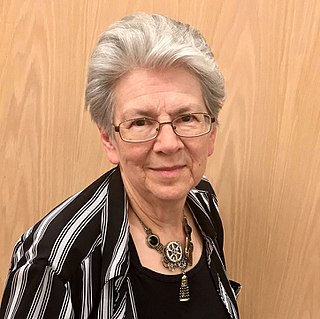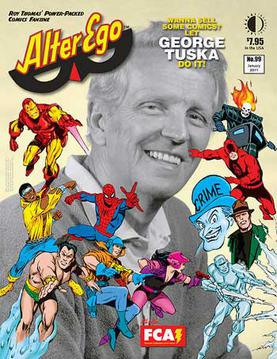
A fanzine is a non-professional and non-official publication produced by enthusiasts of a particular cultural phenomenon for the pleasure of others who share their interest. The term was coined in an October 1940 science fiction fanzine by Russ Chauvenet and first popularized within science fiction fandom, and from there the term was adopted by other communities.

The Comics Journal, often abbreviated TCJ, is an American magazine of news and criticism pertaining to comic books, comic strips and graphic novels. Known for its lengthy interviews with comic creators, pointed editorials and scathing reviews of the products of the mainstream comics industry, the magazine promotes the view that comics are a fine art, meriting broader cultural respect, and thus should be evaluated with higher critical standards.

Dave Sim is a Canadian cartoonist and publisher, known for his comic book Cerebus, his artistic experimentation, his advocacy of self-publishing and creators' rights, and his controversial political and philosophical beliefs.

Comics Buyer's Guide, established in 1971, was the longest-running English-language periodical reporting on the American comic book industry. It awarded its annual Comics Buyer's Guide Fan Awards from 1983 to circa 2010. The publication ceased with the March 2013 issue. The magazine was headquartered in Iola, Wisconsin, after originally being published in the Quad Cities region.

Maggie Thompson is an American longtime editor of the now-defunct comic book industry news magazine Comics Buyer's Guide, science fiction fan, and collector of comics.
The Comic Art Convention (CAC) was an American comic book fan convention held annually New York City, New York, over Independence Day weekend from 1968 through 1983, except for 1977, when it was held in Philadelphia, Pennsylvania, and 1978 to 1979, when editions of the convention were held in both New York and Philadelphia. The first large-scale comics convention, and one of the largest gatherings of its kind until the Comic-Con International in San Diego, California, it grew into a major trade and fan convention. It was founded by Phil Seuling, a Brooklyn, New York City, teacher, who later developed the concept of comic-book direct marketing, which led to the rise to the modern comic book store.
Rory Hayes was an American underground cartoonist in the late 1960s and early 1970s. His comics were drawn in an expressionistic, primitivist style and usually dealt with grim subject matter such as paranoia, violent crime, and drug abuse. In addition to his own titles, Bogeyman and Cunt Comics, he was published in many of the most prominent comics in the underground scene, including Bijou Funnies and Arcade.
Jerry Gwin Bails was an American popular culturist. Known as the "Father of Comic Book Fandom," he was one of the first to approach the comic book field as a subject worthy of academic study, and was a primary force in establishing 1960s comics fandom.

Alter Ego is an American magazine devoted to comic books and comic-book creators of the 1930s to late-1960s periods comprising what fans and historians call the Golden Age and Silver Age of Comic Books.
Notable events of 1971 in comics.
WE Seal of Approval Program (WSA) was a consumer protection/anti mail fraud program that assisted collectors of nostalgia between 1970 and 1984 who had been victimized by fraudulent advertisers in hobbyist magazines. It aided collectors of comic books, Star Trek, movie memorabilia, pulp magazines, and baseball cards. Comic fandom historian Sean Kleefeld has dubbed it "an ersatz Better Business Bureau for the comic fandom industry while it was moving from amateur to professional capabilities."
Michael Catron is an American comic book editor and publisher. He is former publisher of Apple Comics and co-founder of Fantagraphics.
CAPA-alpha was the first amateur press association (APA) devoted to comic books, started by Jerry Bails in the United States in 1964.

Gary Groth is an American comic book editor, publisher and critic. He is editor-in-chief of The Comics Journal, a co-founder of Fantagraphics Books, and founder of the Harvey Awards.

Kim Thompson was an American comic book editor, translator, and publisher, best known as vice president and co-publisher of Seattle-based Fantagraphics Books. Along with co-publisher Gary Groth, Thompson used his position to further the cause of alternative comics in the American market. In addition, Thompson made it his business to bring the work of European cartoonists to American readers.
New Media Distribution/Irjax Enterprises was a comic book distributor and publisher active from the mid-1970s to the mid-1980s. In 1978, the company's legal actions against the dominant distributor of the era, Sea Gate Distributors, widened the field for the direct market to expand. In 1982, when Irjax's distribution arm went out of business, its processing centers and warehouses formed the basis for Diamond Comics Distributors, the now-dominant comics distributor.

The Comic Reader (TCR) was a comics news-fanzine published from 1961 to 1984. Debuting in the pre-direct market era, TCR was the first regularly published comics industry news fanzine, and was able to secure many contacts from within the ranks of the larger publishers. As TCR increased in popularity and influence, it was able to attract professional artist to illustrate the covers. TCR also proved to be a launching pad for aspiring comic book creators, many of whom published work in the fanzine as amateurs. Contributors from the world of fandom included founding editor Jerry Bails, key editor Paul Levitz, Paul Kupperberg, Tony Isabella, Byron Preiss, Neal Pozner, Don Rosa, Carl Gafford, and Doug Hazlewood.

Rocket's Blast Comicollector (RBCC) was a comics advertising fanzine published from 1964 to 1983. The result of a merger with a similar publication, RBCC's purpose was to bring fans together for the purpose of adding to their comic book collections. It also proved to be a launching pad for aspiring comic book creators, many of whom corresponded and exchanged their work through RBCC, and published work in the fanzine as amateurs.
The Goethe Award, later known as the Comic Fan Art Award, was an American series of comic book fan awards, first presented in 1971 for comics published in 1970. The award originated with the fanzine Newfangles and then shared close ties with The Buyer's Guide to Comics Fandom.
James Van Hise is an American popular culture historian and comic book author. He had a long connection with the popular fanzine Rocket's Blast Comicollector (RBCC), and was its editor/publisher from 1974 to 1983. He also had a lengthy association with Hal Schuster, owner of New Media Publishing and Pioneer Books. Van Hise is the author of more than ten books, many of them published by Pioneer Books.










